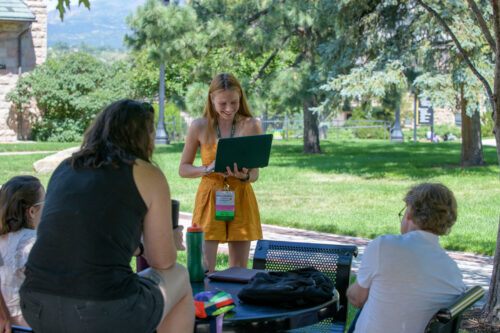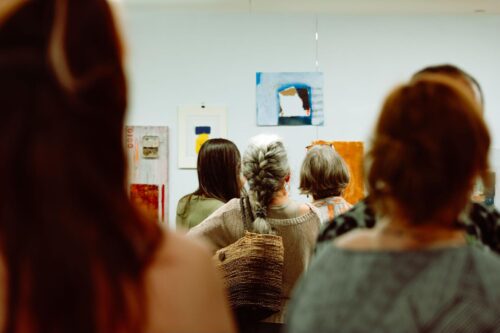What Does a Low-Residency MFA Really Mean?

VCFA MFA in Music Composition candidate during a classroom presentation. Photo of Alex Kirkman (MC ’25), MFA in Music Composition.
Published: 10/27/2024
Low-residency is not an online MFA degree experience… but what is it? In this article, we’ll cover:
- What low-residency means
- How low-residency can benefit and fit into your personal and professional life
- If a low-residency MFA program is right for you
What is a low-residency MFA experience?
MFA degree programs often fall into three different categories: online programs, in-person residential programs, and low-residency programs. Online degrees are performed completely online from a remote location; in-person residential programs require learners to move to a campus location for a set amount of time to complete their MFA degree; and a low-residency program is… neither of these things.
A low-residency MFA program meets in-person for a select amount of time each semester for a residency experience. Post residency, your semester is completed at home, online, with minimal disruption to your personal or professional life.
For example, at VCFA—a strictly low-residency graduate arts institution specializing in Film, Graphic Design, Music Composition, Visual Art, Writing, and Writing for Children & Young Adults—students meet twice a year in-person for nine-day residencies. These intense and vibrant in-person residency programs are full of performances, exhibitions, readings, lectures, workshops, critiques, and networking opportunities. After residency, students return to their homes with an individualized study plan and a faculty advisor. With their advisors one-on-one guidance and feedback, students complete their own projects tailored to their artistic interests and goals. Throughout the semester, students exchange work with their advisor, and even meet online to discuss their work.
“I have a full-time job, which means a full-time responsibility, and yet I’ve been able to find the space to do my craft.” –Diego Antoni (W ‘24), MFA in Writing
So a low-residency MFA program is not an online program, and it’s not a full-time residential program. It is a unique graduate experience that fits into the schedule of its individual students.
How can a low-residency MFA program benefit you?
The most beneficial aspect of a low-residency MFA degree program is that it’s the best of both worlds in the sphere of graduate education. Through a low-residency MFA structure, you:
- Don’t have to uproot and disrupt your personal life for your degree
- Don’t have to take time away from any career/professional opportunities
- Don’t ever have to sacrifice the quality of your education
- Can fit your personalized study into your schedule without creating disruptions
- Can still access the amazing in-person connections and networking opportunities one might find in a residential graduate experience
“I was looking at graphic design programs, and one thing that was stressing me out was that I would have to take a break from my career. I’d spent years working in an agency and wasn’t sure how to take a break—what would happen to the financial responsibility I had to my family? Then I came across the low-residency program… VCFA was the only school I applied to.” –Shruthi Manjula Balakrishna (GD ‘19) MFA in Graphic Design

Alumnx involvement at residency creates an environment of student-led learning, and allows for intimate workshops with a low student-to-faculty ratio. Photo of Rebecca Bendheim (WCYA ’21), MFA in Writing for Children & Young Adults.
A low-residency MFA understands the personal and professional commitments of its learners. Students of low-residency programs are full-time and part-time employees, business owners, entrepreneurs, teachers, parents, care-takers, community leaders, and more.
Plus, on top of the personal and professional benefits, low-residency MFA students often enjoy a more intimate educational experience. Workshop sizes in a low-residency program average 6.5 students per workshop compared to a 10.5 student average in a full-residency program. And given the mentorship model of most low-residency programs, students are guaranteed high-levels of attention and critique from faculty advisors.
“One all-important advantage of the low-residency model is that it allows for much more individualized attention. Whereas a teacher in a traditional program typically has 30–45 students per semester, a teacher in a low-residency program usually has only five, and works one-on-one with each of them. Because the teachers work with so few students, they’re able to critique considerably more work by each one, and to provide considerably more extensive and intensive critiques as well. During the course of a semester, low-residency instructors typically critique five monthly packets of work by each student.” –David Jauss, MFA in Writing faculty
Lastly, a low-residency MFA can be done at any point in your life or career—whether you graduated from your undergraduate program one year ago or twenty years ago. No matter your place in life, a low-residency MFA program comes in to meet it.
“The program at Vermont College of Fine Arts, I thought it was perfect because it was a wonderful hybrid of being able to collaborate in-person with filmmakers but then at the same time to have that flexibility so I could continue my life in New York City or anywhere else.” –Brad Bailey (F ‘21), MFA in Film
Is a low-residency MFA program right for you?
By earning an MFA degree through a low-residency graduate program, artists are transformed by the mentorship-model, their faculty advisors, and their intensive individualized study. Students walk away from their MFA with a greater understanding of craft, voice, artistic practice, and a full portfolio of work that has been professionally critiqued and refined.
If you’re passionate about developing your art, engaging in a fulfilling and thorough graduate program, and maintaining the rhythm of your personal and professional life, then yes, a low-residency MFA experience might be the best fit for your educational journey.
“I was able to work wherever in the country and also be working with the best graphic design faculty. It was really flexible and I really liked that I didn’t have to commit to one place.” –Olivia Schneider (GD ‘22), MFA in Graphic Design

Still want to learn more about low-residency MFA programs? Watch our video on the low-residency model, or read about a current low-residency student on their MFA journey.

